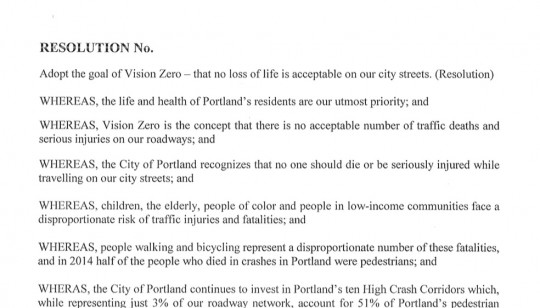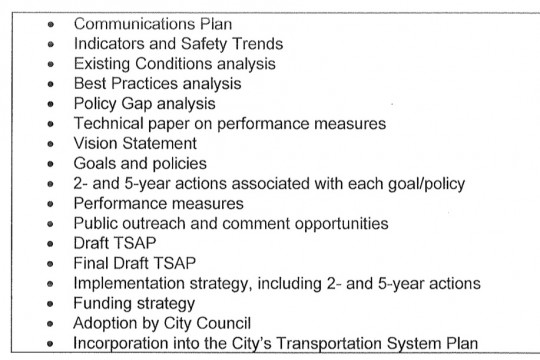On Wednesday Portland City Council is poised to take two steps on the road toward a full embrace of Vision Zero. They’ll formally adopt a goal that “no loss of life is acceptable on our city streets” then they’ll accept a $150,000 grant from the Oregon Department of Transportation to develop a plan to help them reach it.
“… The City of Portland lacks a comprehensive plan and strategy to address traffic safety and move toward this aggressive target.”
— City Council Ordinance No. 615
This week’s Council action comes on the heels of yet another high-profile traffic collision that has spurred a protest and more calls for Mayor Charlie Hales and PBOT Commissioner Steve Novick to take concrete action that leads to safer roads.
In related news, last Thursday the City of Portland Bureau of Transportation issued a Request for Proposals (PDF) to find a consultant who will lead a planning process that will (hopefully) end with the Council’s adoption of the Vision Zero Traffic Safety Action Plan and its inclusion into the city’s all-powerful Transportation System Plan. (It’s worth noting that, six years after it was adopted by Council, our Bike Plan for 2030 still hasn’t been integrated into our Transportation System Plan.)
Support for Vision Zero — the idea that we should not accept a single injury or death on our roads — has slowly emerged as a key pillar of PBOT’s future under the leadership of Director Leah Treat. ‘Embrace Vision Zero’ is the title of one of the five sections in the two-year PBOT action plan she released back in February.
I’ve taken a closer look at the council resolutions (the grant and the adoption of Vision Zero) and the RFP to find out what we can expect in the coming months.
The main goal of the effort is to produce an over-arching plan that will guide the city’s engineering, education, and enforcement efforts as well as a communications plan that will include a new website. Why is this plan needed? In the City’s own words, “While safety is a component of many Portland transportation projects, the City of Portland lacks a comprehensive plan and strategy to address traffic safety and move toward this aggressive target.”
Here are more excerpts from the Council resolution to give you a sense of how PBOT’s Vision Zero narrative is shaping up:
“This grant will fund the development of Portland’s TSAP [Transportation Safety Action Plan] and coalesce leaders in the Portland Metro area around Vision Zero, providing a sustainable long-term footing for a new, more robust approach to transportation safety for the Bureau. The TSAP will outline specific short-term and mid-term engineering, education, and enforcement efforts that the Portland Bureau of Transportation and other agencies will accomplish in order to achieve zero deaths or serious injuries on Portland roadways.
Portland’s Vision Zero goal is audacious – it is to achieve zero fatalities or serious injuries on our roadways by 2025. The Vision Zero Implementation Plan will be Portland’s roadmap to achieving that goal. The Plan will be adopted by City Council and the policies will be incorporated into Portland’s Transportation System Plan.”
Advertisement
As per usual, the process will be heavy on committees and stakeholders. In this case, three advisory committees will be established: An executive steering committee made up of elected officials and agency directors; a policy advisory committee made up of high-level managers; and a technical advisory committee made up of staff from participating agencies and organizations.
Specifically, here are some of the deliverables associated with the plan:
In their grant application, PBOT was asked to list several “quantifiable products or outcomes that address those problems identified… that should result from the proposed activities” along with expected dates of completion. Here’s what they listed:
- Communicate with the public to develop an understanding of, and support for, Vision Zero.
- Develop a clear understanding of the safety challenges on our roadways and the best practices nationwide in developing an aggressive and successful TSAP.
- Bring together a coalition of diverse partners and stakeholders to leverage opportunities to address traffic safety in a meaningful way, as well as to make the culture shift within each group represented to embrace Vision Zero.
- Develop policies, actions and measures that will provide the roadmap to Vision Zero.
- Engage the public and partners such as ODOT in the TSAP effort through social media, website, education campaigns, and public feedback opportunities.
PBOT says Portland’s plan to implement Vision Zero will be modeled after recently completed plans from New York City and San Francisco.
For some PBOT veterans, this renewed focus on traffic safety might feel a bit familiar. Back in 2003, following a survey that found a majority of Portland were concerned about traffic safety, the City of Portland created the Community and School Traffic Safety Account (a.k.a. the Community and School Traffic Safety Partnership, or simply CSTSP). This account, enshrined in city code FIN 4.01, established the Traffic Safety Coordination Council and it was funded in part by traffic citation revenue.
The impetus behind the formation of the CSTSP sounds a lot like what we’re hearing 12 years later around Vision Zero:
“… a response to the strong public demand for services that protect neighborhoods from the negative impacts of traffic and provide a safe environment for all modes of travel. It is a community-based, coalition-led effort to improve Portland’s traffic safety. The CSTSP calls for targeted traffic safety investments in three major program areas reducing crashes associated with driver error, improving pedestrian and bicycle safety, and enhancing safety around schools. Efforts in each of these major areas have a balanced approach, employing engineering, education, and enforcement strategies. As part of the program, PDOT envisions a comprehensive annual evaluation of the CSTSP, including development of performance measures to both track effectiveness and guide future investments. The mission of the CSTSP is to improve traffic safety for all modes; to create a conducive environment that supports increased walking, biking, taking transit, and responsible motorist behavior; and to enhance neighborhood livability by implementing strategic, collaborative, and sustainable traffic safety improvements.”
The Safety Coordination Council still exists today. It’s headed up by PBOT staffer Sharon White and participants meet monthly. The most high-profile activity White and the Council are responsible for are crosswalk enforcement actions.
The web link that used to go to the CSTSP website now redirects to PBOT’s Vision Zero page.
The city estimates that the creation of their Vision Zero Action Plan will take 12 months.
Let’s hope that in 2016 — 13 years after the last time PBOT responded to public demands for safer streets — we at least have what PBOT admits they lack today: “a comprehensive plan and strategy to address traffic safety and move toward this aggressive target.”



